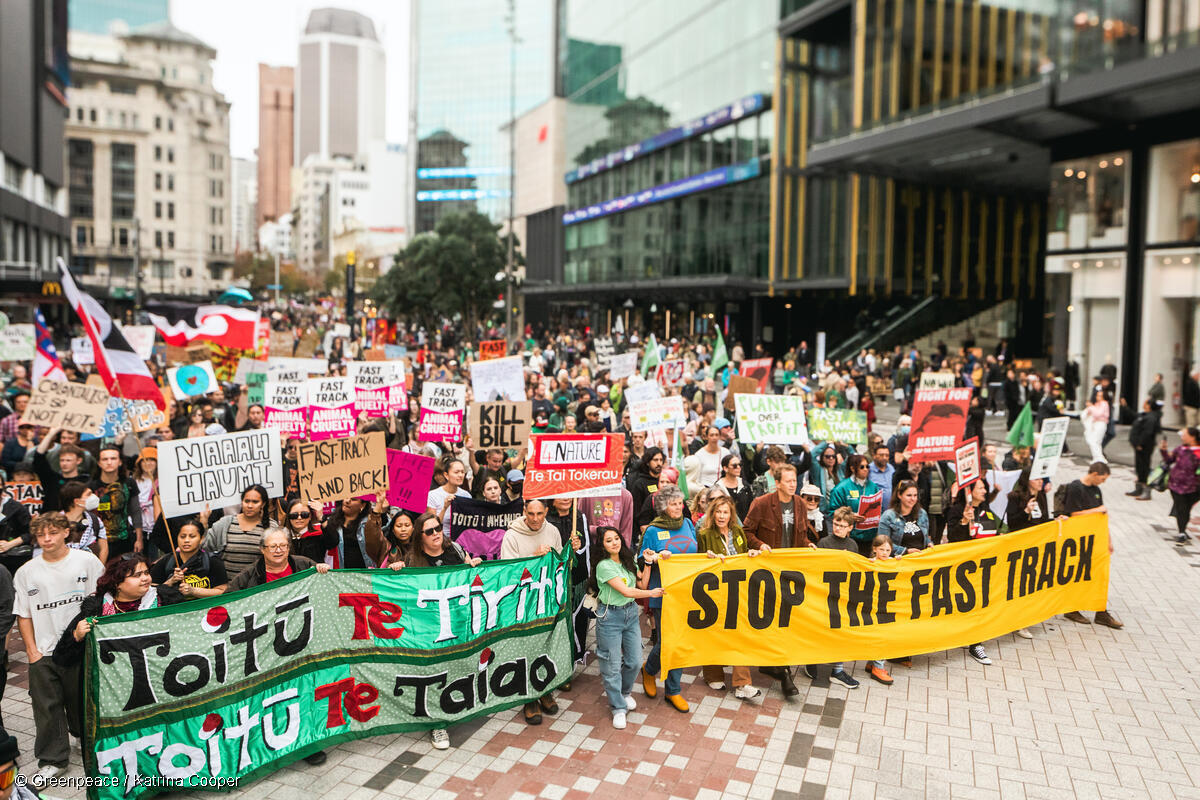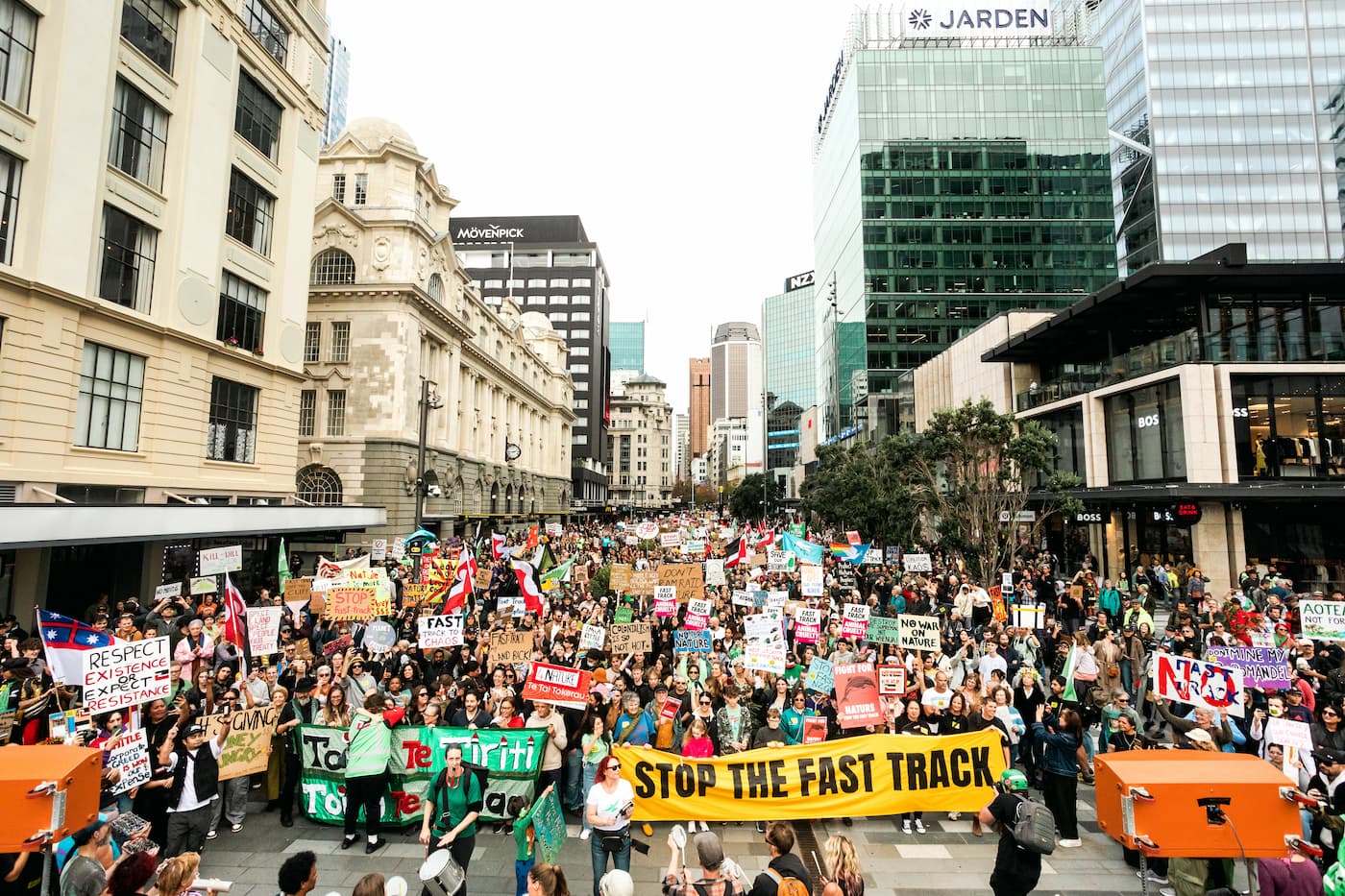Introduction
We thank the Select Committee for the opportunity to submit on the Summary Offences (Demonstrations Near Residential Premises) Amendment Bill (the Bill).
Public protest is a vital part of a healthy democracy and a core way that citizens can directly express their views to decision-makers. Throughout New Zealand’s history, protest has driven the social and political changes we all benefit from today – from the campaign for women’s suffrage, to the fight for labour rights, to our proud nuclear-free stance.
This Bill proposes to create a new criminal offence for protest. It seeks to penalise citizens for “engaging in targeted and disruptive demonstration near residential premises”.
Greenpeace Aotearoa opposes this Bill. A vibrant and healthy democracy relies on citizens having freedom to challenge and disagree with elected representatives, even when it makes those in power uncomfortable.
The effectiveness of protest relies on the ability of citizens to choose the time and place of their demonstration, ensuring their message is seen and heard by those with the power to act. The Supreme Court underscored this principle in Morse v Police, affirming that it is legitimate for protestors to make choices of time, place and circumstance in order to be effective.
As drafted, the Bill’s scope is dangerously broad. It would restrict protest outside private homes but also outside embassies, which are often the official residences of ambassadors, and in central civic areas if decision-makers residences are nearby.
Protest in these places has long been part of New Zealand’s democratic culture. Citizens should not be criminalised for peacefully demonstrating outside embassies, in public spaces, or at the homes of those in power. Therefore, this bill must be rejected.
New Zealand already has a comprehensive legal framework to address genuinely harmful or unlawful conduct in protest. The Summary Offences Act contains multiple provisions on disorderly behaviour and assembly, offensive language, intimidation, obstructing a public way, and resisting police. These laws already balance the right to protest with the rights of others to safety, privacy, and public order.
The poor drafting of this Bill invites overreach and suppression of lawful protest, which would create a chilling effect on public participation in our democracy. It would allow Police to assert that peaceful protestors are being criminally disruptive and to shut down demonstrations, whether or not that assessment is justified. The Bill also contains no requirement for Police to issue a warning before making an arrest, granting an unacceptable degree of discretionary power and creating a serious risk that peaceful protestors will be detained or prosecuted for lawfully exercising their democratic rights.
All governments, of all stripes, should strive to build a stronger, fairer democracy in Aotearoa – one where all people have a say on the decisions that affect them. This Bill does the opposite: it undermines our democracy and it is in conflict with the rights of New Zealanders to freedom of expression, freedom of peaceful assembly, freedom of association, and freedom of movement which are affirmed in the Bill of Rights Act (NZBORA). A participatory democracy must uphold these rights.
New Zealanders should be encouraged to including the right to criticise and scrutinise decisions of elected officials through protest.
This Bill is an undemocratic attempt to shield decision-makers from the discomfort of public dissent. If enacted it would criminalise lawful protest, chill participation in civic life, and undermine the freedoms that allow New Zealanders to hold those in power to account.
For these reasons, Greenpeace Aotearoa urges the Committee to reject the Bill. The following submission outlines our arguments in more detail.
Threat to Fundamental Democratic Rights
- The Summary Offences (Demonstrations Near Residential Premises) Amendment Bill (the Bill) proposes to amend the Summary Offences Act 1981 to create a new offence of “engaging in targeted and disruptive demonstration near residential premises”.
- The Bill is introduced under the guise of strengthening the right to privacy. However, at its core, the Bill represents a direct threat to several rights affirmed by the New Zealand Bill of Rights Act 1990 (NZBORA) associated with political protest, including freedom of expression, freedom of peaceful assembly, freedom of association, and freedom of movement.
- Public protest is a crucial aspect of New Zealand’s participatory democracy. Protest provides means of political participation for citizens, for them to have their voices heard by the government of the day and the wider community.
- In 2007, the Supreme Court considered the issue of protest outside a private residence. Brooker v Police concerned an appellant convicted of disorderly behaviour, having protested loudly on the street outside a police officer’s residence. In quashing the conviction, the Supreme Court held that the protesters right to freedom of expression outweighed the police officer’s privacy interest in the circumstances. The majority emphasised the fact that the appellant was engaging in a protest, an important manifestation in need of protection, and that “a tendency of behaviour to annoy others, even seriously, is insufficient to constitute a disruption to public order which may make restrictions upon freedom of expression necessary”.
- While the Bill is introduced under the guise of ensuring the law “appropriately balances a person’s right to privacy” with “the rights and freedoms affirmed by [NZBORA]”, it undermines the ability to protest in an effective way. The choice of location is often a crucial aspect to a protest or demonstration. An assembly which wants to convey a particular opinion or statement to the government is most effective at a time and place when and where the government is forced to take notice.
- Freedom of expression and freedom of peaceful assembly includes the freedom to choose the place at which opinion is expressed to ensure it has the greatest impact. The fundamental importance of “the right to protest in an effective way” underscored the Supreme Court’s finding in Morse v Police that it is “legitimate for those wishing to protest to make choices based on time, place and circumstance as to the most effective manner of doing so”.
- As McGrath J emphasised in Brooker v Police, “respect for protest as a means of pressing for change in official policy or conduct is very much part of New Zealand’s culture and societal values”.
- To prohibit all protest in residential areas would place undue emphasis upon place in the time, place and circumstances evaluation and would not be justifiable in light of the objective of strengthening privacy interests and maintaining the public order.
Existing Legal Protections Already Balance Protest and Privacy
- There is no doubt that protests can be, and are sometimes even intended to be, disruptive. However, a multitude of offences exist that balance the right to protest with the right of the public not to be subjected to disorderly behaviour.
- Freedom of peaceful assembly is generally limited in the name of the public order and, depending on the location of the assembly, by road-use or private property rights. For example, the Summary Offences Act 1981 contains several offences against the public order that limit protest demonstrations including disorderly behaviour, offensive behaviour or language, disorderly behaviour on private premises, and disorderly assembly. Offences of intimidation, obstructing public way and resisting Police also limit protest activity.
- Trespass offences contained in the Trespass Act 1980 restrain, and effectively prohibit, protest activity on private property. Offences of wilful damage and graffiti vandalism, tagging and defacing specifically limit protest activity involving damage to private property. The more serious offence of intentional damage, carrying a maximum penalty of 7 years’ imprisonment, is also available for property damage.
- Evidently, there is a wide range of offences that regulate behaviour that crosses the line from lawful protest activity that is merely disruptive or a nuisance, from that of which disturbs the public order.
- The Bill defines disruption in relation to residential premises as –
- a disruption to the use of or enjoyment of those premises by any regular occupant of those premises; and
- includes a disruption to the ability of any regular occupant of those premises to enter or leave those premises.
- So, for protest activity to amount to an offence under the Bill, it would need to be disruptive – or disorderly. Disorderly conduct is already an offence under existing legislation. Time and place are very much relevant considerations in assessing whether protest activity amounts to disorderly behaviour, as Elias CJ held in Brooker v Police:
The victimisation or bullying inherent in a sustained or intrusive targeted protest against a particular home is likely to disrupt public order in the sense of causing alarm or perception of threat. But a peaceful protest or picket which is simply annoying or embarrassing and which does not seriously interfere with use of the neighbourhood by others does not become disorderly simply because it is conducted in a residential street.
- The Bill seeks to restrict protest activity beyond what Elias CJ envisaged to cross the line into disruption of the public order, and as such it is a restriction of peaceful protest, which is dangerous to our democracy.
Unreasonable Breadth of Criminalisation of Peaceful Protest
- The breath and vague drafting of the Bill is likely to have immense practical implications and may be used to suppress less proximate forms of protest, for example, a protest on major road in a majority city might conceivably be treated as “near” to a residential premises and disruptive to that premises or others.
- The Bill makes no attempt to define what amounts to “near” a residential premises. It is not clear what level of proximity is criminalised. “Residential premises” has been afforded an extraordinarily broad definition of “a building, or part of a building, that is a house, flat, town house, home unit, or similar dwelling erected, or currently used, mainly as a place of residence, and any land, improvements, or appurtenances belonging to the dwelling or usually enjoyed with it”. The circumstances the offence introduced by the Bill seeks to criminalise could conceivably extend to any number of situations.
- For example, were a government official to have a residence on Lambton Quay or Queen Street, the Bill would effectively suppress protest against their actions in those ordinary and long established locations of protest. Additionally, if the ambassador resides at an embassy protest outside that embassy would be captured under this bill.
- Disruption to other residential premises is also included in cl 5B(1)(b)(ii) meaning the Bill would criminalise protest that does not actually cause any unreasonable disruption to the person targeted. Furthermore, as framed, the Bill does not require a person to know that the premises are occupied by the target of the protest. The only knowledge requirement concerns the disruption of residential premises. This leads to a possibility that protest action will be criminalised in circumstances where the participant in the protest has no knowledge that the target of their protest lives in a premises being disturbed by their protest.
- The Bill contains no element requiring that the demonstration is actually unreasonably disruptive as a matter of fact. Rather, disruption is only relevant to the person’s state of mind. This creates the spectre of liability for a demonstration that is not actually disruptive at all.
- The Bill is so vague that prospective compliance with the law – a fundamental tenet of the Rule of Law – is impossible. The effect will be to chill protest as those wishing to protest will have difficulty ascertaining whether they are committing an offence or not (for example, whether conduct is “near” a residential premises; whether conduct is “directed” at an occupant; whether conduct is “disruptive”; whether conduct is “unreasonably” disruptive in the circumstances including those listed in the Act; and what a person “ought” to know).
- Moreover, the vagueness in the drafting of the offence is likely to embolden the Police to assert that conduct is criminally disruptive and to effectively shut down protest, whether that position is (or proves to be) correct or not. In other words, the broad framing creates a risk of overenforcement and suppression of lawful protest, which is already a problem with the disorderly conduct offence (as borne out in Brooker and R v Morse).
Conflict with International Human Rights Obligations
- The explanatory note points to an intention to give effect to Article 17 of the ICCPR which affirms the right to be free from arbitrary or unlawful interference with one’s privacy, family and home. While it is true that Article 17 protects that right, the logic of the explanatory note is flawed:
- Article 17 only concerns arbitrary and unlawful interference – peaceful protest near someone’s home is not arbitrary nor is it unlawful;
- It ignores Article 19(2) which affirms the right to freedom of expression; this right shall include freedom to seek, receive and impart information and ideas of all kinds, regardless of frontiers, either orally, in writing or in print, in the form of art, or through any other media of his choice.
- It ignores Article 21 which affirms the right to peaceful assembly;
- It ignores Article 22 which affirms the right to freedom of association.
Conclusion
- A healthy democracy must uphold citizens’ rights to political participation, including the ability to criticise and scrutinise elected officials through peaceful protest – whether outside embassies, the homes of public officials, or in other spaces.
- Ultimately, this Bill appears to be more of an attempt to shield those in power from the discomfort of public dissent than an attempt to protect privacy.
- Unlawful and unreasonable interferences with privacy and family life can already be addressed through the summary offences of disorderly or offence conduct, tortious claims of interference with privacy, and criminal provisions relating to harassment. This Bill extends restrictions on otherwise lawful and peaceful protest, and attempts to dissuade persons from lawful protest by imposing a vague shadow of criminal liability should a person wishing to protest misjudge, or be held to misjudge, the level of “disruption” they are causing.
- The Bill is unnecessary, it will criminalise and chill lawful peaceful protest, and it will ultimately undermine New Zealand’s vibrant and healthy democracy.
- It should not be passed. We urge the select committee to reject this Bill in its entirety.
Annex 1 – About Greenpeace Aotearoa
Greenpeace is a global, independent campaigning organisation that acts to protect and conserve the environment and to promote peace. Greenpeace is one of the world‘s largest and oldest environmental organisations, operating for half a century, since 1971, and now works in more than 55 countries. The New Zealand branch of Greenpeace (Greenpeace Aotearoa) was founded in 1974 and represents many tens of thousands of supporters. Our mission is to ensure Earth’s ability to nurture life in all its diversity.
Greenpeace Aotearoa recognises Te Tiriti o Waitangi signed in Te Reo Māori on 6 February 1840 as the foundation for the relationship between the Crown (and so the New Zealand Government) and the indigenous hapū of Aotearoa. Greenpeace Aotearoa recognises that Te Tiriti o Waitangi affirmed the sovereignty of the tangata whenua, which has never been relinquished despite the violent colonisation of Aotearoa.




